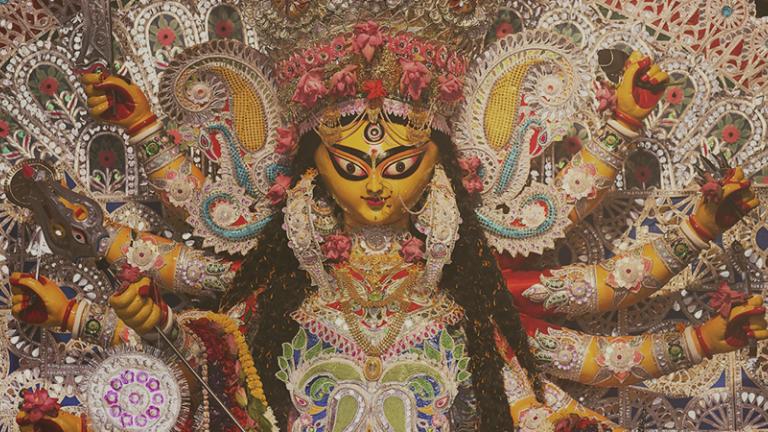Dr. Elizabeth Allison on training leaders for ecological change.

Shakti: Awakening the Powers of the Inner Goddesses
The yogic teachings on Shakti are particularly relevant to this contemporary moment in human history
I discovered the power of the Goddess quite unexpectedly. It happened in India, on the second night of a festival called Navaratri, which celebrates the divine feminine as the warrior Durga, slayer of the demons of ego and greed. Like so many festivals in India, Navaratri is both a big party and an occasion for mystical communion with the divine. Women put on their most gorgeous clothes, temples overflow with worshippers. Nights are filled with dancing and story-telling. People have heightened, even visionary, experiences of the energy that the festival invokes.
That night, several hundred of us had gathered amidst a blaze of candles next to a huge statue of Durga, eighteen feet high in her red sari, seated on top of a white tiger, arms bristling with weapons. I had been chosen to speak, to tell one of my favorite mythological tales, the story of the romance of the Goddess Sati. I was psyched for it, excited by the opportunity to tell a story—something I love to do—in such a heightened atmosphere.
But when I stood up to speak , I was seized by a feeling much bigger than excitement. It was a kind of ecstasy, a deep pulsing joy that nearly undid me where I tried to form the words of my tale. Later, I would learn to recognize this as one of the characteristic signatures of the Goddess’s presence. The divine feminine has a thousand names and a thousand moods, but when she chooses to show up for you, she very often shows up as ecstasy.
Ecstasy is a feeling that is hard to convey, but impossible to ignore. Every few minutes, I had to stop talking because tears kept threatening to break through my voice. When it was over, I knew that something had just happened which would change everything.
Truthfully, it wasn’t only the content of the story that moved me. It was the energy itself, the pulsing, love-saturated, subtly sensual energy that rose in the atmosphere as we invoked the Goddess. That energy seemed to be telling me that there are secrets, ways of being in the universe, that only the divine feminine can reveal. After that night, I began to ‘see’ her everywhere, almost as if she were pursuing me. I went about my normal existence, which was highly scheduled and mostly work-centered. But every now and then, ‘she’ would show up. Once as a palpable presence who seemed to hover in the air next to me, emanating soft waves of, yes, maternal tenderness. More often, I would sense her as a subtle sensation of luminosity that would infuse the air, or as an inner feeling of joy, or a sensation of being surrounded by a soft, embracing awareness.
One effect of all this was to make me fall in love with the natural world. My new awareness of the Goddess spilled over as a heightened consciousness of trees and landscapes, so that what had seemed matter of fact and dull now began to vibrate with sentience. I would find myself staring up at a eucalyptus tree as if it were a lover, or looking out over a landscape with a feeling that it was alive and breathing. I began to practice a meditation where I imagined that the trees and the air were ‘seeing’ me, and when I did that, the borders of my skin-encapsulated sense of self would soften, and I would ‘know’ that the world and myself are part of the same fabric. Goddess awareness literally put me in touch with something that felt like the soul in the physical world.
And it also made me start looking deeper into the myths of the Hindu goddesses, and into the practices of sacred feminism. As others have before me, I intuited that we are entering the time when Sati will definitively take her place in the world once more.
The yogic teachings on Shakti are particularly relevant to this contemporary moment in human history. The yogic sages—especially in the branch of yoga called Tantra—anticipated quantum physics by pointing out that a subtle vibratory energy is the substratum of everything we know. Unlike physicists, however, yogic seers experienced this energy not simply as an abstract vibration, but as the expression of the divine feminine power, called Shakti. The word shakti literally means power. Shakti the innate power in reality, has five faces. It manifests as the power to be conscious, the power to feel ecstasy, the power of will, or desire, the power to know, and the power to act.
All these powers come into play in the act of cosmic creativity, when divine intelligence spins a universe out of itself, much the way a human mind creates a dream or a fantasy on its own screen. The cosmic creation explodes in a Big Bang, and then evolves over millions of years as suns, planets, increasingly sophisticated life forms, and, of course, as human beings. All of reality, this tradition says, is Shakti’s dance. Shakti takes form as the biological processes of our body. She acts through our thoughts and the play of our emotions. She becomes every atom and dustmote in the physical world. We are, in our essence, made of Shakti. Her powers of consciousness, ecstasy, will, knowing, and acting are constantly at play both in ourselves and the world.
But the tantras weren’t content with a generalized vision of energy-as-Shakti. They adapted it to the mythic context of their time, and in an additional leap of insight, created a science for transforming human energy through the goddess figures of the Hindu pantheon.
The practices they used combined sacred sounds—mantras--, images, and geometric figures called yantras. Taken together, these meditations constituted a sacred technology, with immense power to help us open to the hidden energies within ourselves, as we contemplate the personalized forms that sacred energy takes. The most powerful expressions of these technologies are the empowered mantras that not only invoke, but actually contain the energies of the goddesses.
In my book, "Awakening Shakti," I discuss eleven goddesses: Durga (Hard-to-Conquor), the warrior, cosmic protector, and empowering Mother.
Kali (the Black One)—the mysterious terrifying, fiercely loving goddess who brings radical change into your life, and ultimately dissolves all forms into the Void. Among her forms are Tara and Bhairavi.
Laksmi (Auspicious)—the goddess of good fortune, wealth, and inner and outer abundance
Saraswati—goddess of creative intuition, music, eloquence, and speech
Lalita Tripura Sundari—Goddess of sacred sexuality as well as the highest form of mystical experience, whose blessing unites the energy of the body with the energy of spirit
Dhumavati—the crone goddess, who teaches us how to turn disappointment into spiritual growth
Sita—The faithful wife, guardian of the womb, goddess of the earth and its mysteries
Radha—the goddess of erotic devotional love, who carries the gift of divine longing and mystical surrender
Bhuveshwari—Goddess of sacred space, who dissolves all limitations into herself, and then creates new forms out of the infinite space.
Parvati—Goddess of the sacred marriage, the divine yogini, who embodies the power of creative will
Some of these goddesses are warriors, while others are lovers. Some have maternal energy, others are dedicated to opening you to mystical realms. Every one of them can be a portal into the deepest realms of the soul, and a guide to the skills of living as an empowered feminine lover of life. Most of us have an inner affinity to one or another of the goddesses. And this can change as we move through our lives.
Sacred Feminism
The practice of tuning into the energies of the Goddesses is a form of sacred feminism—not political feminism, but feminism of the soul. To my generation, feminism was not only a movement for woman’s economic and political equality. It also involved a deep and fearless self-exploration, a commitment to looking inside ourselves to see beyond our conditioned assumptions about masculine and feminine. That exploration got lost in a kind of backlash in the 80s and 90s, but young women are again exploring those questions, even as neuroscience is coming to understand both the differences and the similarities between a masculine and feminine brain. One of the great questions that both women and men are beginning to explore more deeply is the issue of what constitutes true feminine power.
The short answer to this question is that the true power of the feminine is the power of the Shakti. As an interior face, she exists equally in both women and men. Yet most of us are unaware of her, and therefore unaware of the creative potential of our lives. We begin to touch into Shakti when we tune into the energy inside our body. We go even deeper as we set ourselves to experience deeper forms of inner inspiration, and when we begin to listen to the guidance that can flow from the deepest core of ourselves.
To live in tune with that inner power requires that we learn how to tune ourselves to it, and to turn to it often. This is especially true when our goal is spiritual transformation. The tantric traditions of India and Tibet, especially, understood that real inner transformation is a gift of the sacred feminine, and essentially does not happen without her consent. Shakti works through our brain and nervous system to give us the experience of separation and limitation. The tantric sages believed that just as Shakti has a face that ‘binds’ us to the experience of duality, she also has a face that transforms and liberates us from limitation. The liberating face of Shakti is known as kundalini, the coiled energy that is awakened through yoga and other practices. The Tantric sages recognized that the safest, sweetest, and most skillful way to awaken that power inside us is to honor her as the inner form of the divine mother, the Goddess.
Practicing with a mantra—a sacred sound form-- of the Goddess is a particularly powerful way experience your own inner spiritual energy. Of all the mantras associated with deity practice, the most important are the ‘seed’ syllable mantras, or bijas. Bija mantras are sounds that are said to contain the essence of a particular sacred energy—a deity presence—in the same way that an acorn contains the embryonic oak. When you combine the syllable with the name of the Goddess, your practice will, in time, bring her energy alive in you. Each one of the goddesses is invoked with a particular mantra.
For instance, one of the most famous goddess mantras is the bija (seed syllable) aim, pronounced ‘ayeem.’ Aim is associated with the goddess Saraswati (‘the flowing one’) whose energy is associated with sacred sound, creative imagination, music, eloquent speech, poetic inspiration, and spiritual wisdom. Poets and musicians as well as school children in India invoke Saraswati in order to call forth their own musical and linguistic abilities. Meditating on Saraswati with her seed mantra combined with her name can kindle your hidden creative gifts—and also tune you into the hidden sacred sounds that arise in meditation and carry you into the heart. The following meditation is a simple way to call on the energy of Saraswati through sacred sound:
Meditation on the Goddess Saraswati
Seated in a comfortable upright posture, bring your attention into the center of the head, in the midbrain.
Feel that the breath is flowing in two streams through the nostrils, and coming to rest in the midbrain, in the region known as the Ajna Chakra.
Begin to think the mantra Om aim saraswatyai namaha.
Om is the primordial sound, the articulated form of the energy that sis said to resound in every corner of the universe. Aim is the seed of the Goddess Saraswati. “Saraswatyai” directly addresses her. Namaha means ‘I honor’. So, the mantra means, “I honor the sacred energy of speech and intuitive creativity.”
If you like, you can visualize the presence of the Goddess Saraswati in the center of the head, in the form of a luminous white flame, the size of a thumbnail.
Imagine that the mantra flows in with the breath, touching the flame in the center of the head, and bringing Saraswati awake in the form of subtle awareness.
You may also imagine her seated in front of you, a beautiful feminine form, delicate, with flowing dark hair and pale golden skin. Her clothes are white, and her eyes look directly into yours. In two of her four hands, she carries a veena, a stringed instrument like a lute, which signifies sacred sound and music. In her third hand, she holds a book, and in her fourth hand, a rosary. As you repeat the mantra, feel that the mantra flows between her heart and yours.
If you like, you can ask her a question, or just sit quietly and feel her energy.
Related Academic Programs
M.A and Ph.D. in East-West Psychology; M.A. in Asian Contemplative and Transcultural Studies
Related News
Ginny Whitelaw brings decades of experience to the Blue Sky Leaders Certificate, helping leaders move beyond ego and into deep connection and purpose.
A graduate’s journey integrating Eastern contemplative wisdom with Western depth psychological frameworks.



